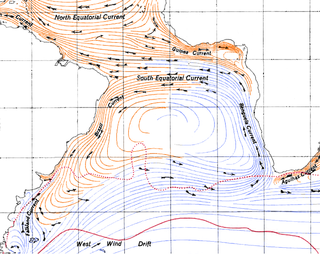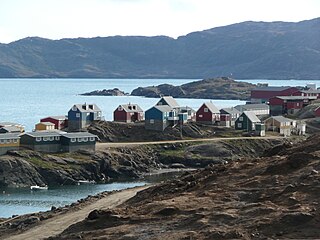
The Atlantic Ocean is the second-largest of the world's five oceanic divisions, with an area of about 85,133,000 km2 (32,870,000 sq mi). It covers approximately 17% of Earth's surface and about 24% of its water surface area. During the Age of Discovery, it was known for separating the New World of the Americas from the Old World of Afro-Eurasia.

The North Atlantic Current (NAC), also known as North Atlantic Drift and North Atlantic Sea Movement, is a powerful warm western boundary current within the Atlantic Ocean that extends the Gulf Stream northeastward.

North Atlantic Deep Water (NADW) is a deep water mass formed in the North Atlantic Ocean. Thermohaline circulation of the world's oceans involves the flow of warm surface waters from the southern hemisphere into the North Atlantic. Water flowing northward becomes modified through evaporation and mixing with other water masses, leading to increased salinity. When this water reaches the North Atlantic, it cools and sinks through convection, due to its decreased temperature and increased salinity resulting in increased density. NADW is the outflow of this thick deep layer, which can be detected by its high salinity, high oxygen content, nutrient minima, high 14C/12C, and chlorofluorocarbons (CFCs).

An ocean current is a continuous, directed movement of seawater generated by a number of forces acting upon the water, including wind, the Coriolis effect, breaking waves, cabbeling, and temperature and salinity differences. Depth contours, shoreline configurations, and interactions with other currents influence a current's direction and strength. Ocean currents are primarily horizontal water movements.

In oceanography, a gyre is any large system of circulating ocean surface currents, particularly those involved with large wind movements. Gyres are caused by the Coriolis effect; planetary vorticity, horizontal friction and vertical friction determine the circulatory patterns from the wind stress curl (torque).

The North Atlantic Gyre of the Atlantic Ocean is one of five great oceanic gyres. It is a circular ocean current, with offshoot eddies and sub-gyres, across the North Atlantic from the Intertropical Convergence Zone to the part south of Iceland, and from the east coasts of North America to the west coasts of Europe and Africa.

The South Equatorial Current are ocean currents in the Pacific, Atlantic, and Indian Ocean that flow east-to-west between the equator and about 20 degrees south. In the Pacific and Atlantic Oceans, it extends across the equator to about 5 degrees north.

The Antilles Current is a highly variable surface ocean current of warm water that flows northwesterly, past the island chain that separates the Caribbean Sea and the Atlantic Ocean. The current results from the flow of the Atlantic North Equatorial Current. This current completes the clockwise- cycle or convection that is located in the Atlantic Ocean. It runs north of Puerto Rico, Hispaniola and Cuba, but south to the Bahamas, facilitating maritime communication from across the Atlantic into these islands' northern coasts, and connecting to the Gulf Stream at the intersection of the Florida Strait. Because of its non-dominant pace and rich-nutrient waters, fishermen across the Caribbean Islands use it to fish. It moves almost parallel to the also rich-nutrient Caribbean Current which flows south of Puerto Rico and Cuba, and over Colombia and Venezuela.

The Caribbean Current is a warm ocean current that transports significant amounts of water and flows northwestward through the Caribbean from the east along the coast of South America and into the Gulf of Mexico. The current results from the flow of the Atlantic South Equatorial Current as it flows north along the coast of Brazil. As the current turns north through the Yucatán Channel, it is renamed the Yucatán Current. The Caribbean Current water comes from the Atlantic Ocean via the North Equatorial, North Brazil, and Guiana Currents. The circulation of the Columbia-Panama Gyre flows counter-clockwise to the Caribbean Current.

The West Greenland Current (WGC) is a weak cold water current that flows to the north along the west coast of Greenland. The current results from the movement of water flowing around the southernmost point of Greenland caused by the East Greenland Current.

The North Pacific Gyre (NPG) or North Pacific Subtropical Gyre (NPSG), located in the northern Pacific Ocean, is one of the five major oceanic gyres. This gyre covers most of the northern Pacific Ocean. It is the largest ecosystem on Earth, located between the equator and 50° N latitude, and comprising 20 million square kilometers. The gyre has a clockwise circular pattern and is formed by four prevailing ocean currents: the North Pacific Current to the north, the California Current to the east, the North Equatorial Current to the south, and the Kuroshio Current to the west. It is the site of an unusually intense collection of human-created marine debris, known as the Great Pacific Garbage Patch.

The Great Pacific garbage patch is a garbage patch, a gyre of marine debris particles, in the central North Pacific Ocean. It is located roughly from 135°W to 155°W and 35°N to 42°N. The collection of plastic and floating trash originates from the Pacific Rim, including countries in Asia, North America, and South America.

A garbage patch is a gyre of marine debris particles caused by the effects of ocean currents and increasing plastic pollution by human populations. These human-caused collections of plastic and other debris are responsible for ecosystem and environmental problems that affect marine life, contaminate oceans with toxic chemicals, and contribute to greenhouse gas emissions. Once waterborne, marine debris becomes mobile. Flotsam can be blown by the wind, or follow the flow of ocean currents, often ending up in the middle of oceanic gyres where currents are weakest.

The Beaufort Gyre is one of the two major ocean currents in the Arctic Ocean. It is roughly located north of the Alaskan and Canadian coast. In the past, Arctic sea-ice would circulate in the Beaufort gyre up to several years, leading to the formation of very thick multi-year sea-ice. Due to warming temperatures in the Arctic, the gyre has lost an extensive amount of ice, practically turning what used to be a nursery for sea-ice to mature and grow into the thickest and oldest ice of the Arctic Ocean into a "graveyard" for older ice.

The South Atlantic Gyre is the subtropical gyre in the south Atlantic Ocean. In the southern portion of the gyre, northwesterly winds drive eastward-flowing currents that are difficult to distinguish from the northern boundary of the Antarctic Circumpolar Current. Like other oceanic gyres, it collects vast amounts of floating debris as a garbage patch.

The Indian Ocean gyre, located in the Indian Ocean, is one of the five major oceanic gyres, large systems of rotating ocean currents, which together form the backbone of the global conveyor belt. The Indian Ocean gyre is composed of two major currents: the South Equatorial Current, and the West Australian Current.

The Indian Ocean garbage patch, discovered in 2010, is a marine garbage patch, a gyre of marine litter, suspended in the upper water column of the central Indian Ocean, specifically the Indian Ocean Gyre, one of the five major oceanic gyres. The patch does not appear as a continuous debris field. As with other patches in each of the five oceanic gyres, the plastics in it break down to ever smaller particles, and to constituent polymers. As with the other patches, the field constitutes an elevated level of pelagic plastics, chemical sludge, and other debris; primarily particles that are invisible to the naked eye. The concentration of particle debris has been estimated to be approximately 10,000 particles per square kilometer.

The Irminger Sea is a marginal sea of the North Atlantic Ocean. It is bordered to the west by southern Greenland, to the north by Iceland and the Denmark Strait, to the east by the Reykjanes Ridge, and to the south by open waters of the North Atlantic.

Labrador Sea Water is an intermediate water mass characterized by cold water, relatively low salinity compared to other intermediate water masses, and high concentrations of both oxygen and anthropogenic tracers. It is formed by convective processes in the Labrador Sea located between Greenland and the northeast coast of the Labrador Peninsula. Deep convection in the Labrador Sea allows colder water to sink forming this water mass, which is a contributor to the upper layer of North Atlantic Deep Water. North Atlantic Deep Water flowing southward is integral to the Atlantic Meridional Overturning Circulation. The Labrador Sea experiences a net heat loss to the atmosphere annually.
A Wind generated current is a flow in a body of water that is generated by wind friction on its surface. Wind can generate surface currents on water bodies of any size. The depth and strength of the current depend on the wind strength and duration, and on friction and viscosity losses, but are limited to about 400 m depth by the mechanism, and to lesser depths where the water is shallower. The direction of flow is influenced by the Coriolis effect, and is offset to the right of the wind direction in the Northern Hemisphere, and to the left in the Southern Hemisphere. A wind current can induce secondary water flow in the form of upwelling and downwelling, geostrophic flow, and western boundary currents.

















